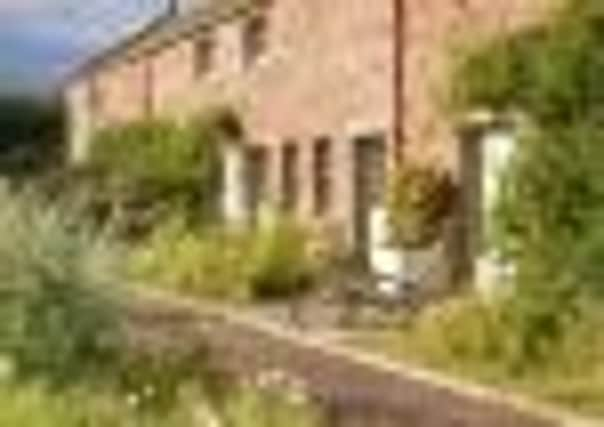Gardens: Linda Shaw-Stewart’s watchwords when planning her East Lothian garden were practicality and realism, and ten years on, the results bear out her philosophy beautifully


Brilliant ideas would flow and solutions be found to practical problems. Plants would thrive and it would take shape in a matter of months.
So it was reassuring to learn that for Linda Shaw-Stewart, who bought an obsolete farm steading with her husband ten years ago, the stunning results – evident even on a wet day – were hard won. There was much trial and error, and plans had to be revisited regularly.
Advertisement
Hide AdAdvertisement
Hide AdThe project started from a low point. Built of red sandstone and set in rolling East Lothian farmland, Eastfield was a derelict collection of buildings set around a generously proportioned central square. “Every roof was rotten and there was so much debris we couldn’t get inside the steading to take a look,” Linda says.
The first priority was repairing the house, now converted into a comfortable family home with south-easterly views over the former stack yard, with fields and wooded areas beyond.
“We couldn’t start planning the garden until we knew how the house would work,” says Linda, who repeatedly emphasises the need for practicality and realism when planning a garden.
They started by planting the belt of trees that now protects the steading from the worst of the winds that come “roaring in from the south-east”. Closer to the house, the wind was filtered by a variety of prunus, birch and a collection of richly berried sorbus.
It took two years to clear the steading and the stack yard, and remove generations of knee-high debris, which included rusted strands of barbed wire, broken farm machinery and rough rubble. Using mostly manual labour, because often only a pick axe could penetrate the soil, the couple were eventually rewarded by the “hugely exciting” discovery of a surface layout of large, dark grey cobbles.
These were to form the basic framework for the layout of a simple, elegant courtyard garden, entered under the original arch into a semi-formal layout of geometrically shaped spaces.
A perimeter walk was laid out along the steading walls, creating the opportunity to observe close up the espaliered trees: orange-berried cotoneaster and white-flowering Hydrangea petiolaris working particularly well against the sandstone. At the heart of the garden is a rectangular lawn, while the highlight of the courtyard is the formal parterre.
Partially enclosed by low stone walls, the parterre features a central, cobble-edged gravel path, about a rounded bed overflowing with froths of yellow Alchemilla mollis. Height comes from the small trees planted in the box squares and the metal arches, an echo of the entrance arch. The scheme is linked to different parts of the garden by tall, terracotta pots overflowing with ebullient hydrangea ‘Annabelle’ and the grey, arching foliage of helichrysum.
Advertisement
Hide AdAdvertisement
Hide AdDespite her obvious energy and enthusiasm for gardening, Linda consistently reinforces the need for simplicity of layout and ease of maintenance, without in any way compromising the end result. The courtyard she says, “is a really large space; I always had the equation of keeping maintenance down but making it interesting to be in”.
This was done by establishing from the start the right layout: she used a combination of existing hard landscaping and hedging material. Establishing basics such as good drainage is important: her own detailed plans for a layout of French herringbone drains were overlooked when the couple went on holiday at the crucial moment. Although the problem is now resolved, the early lack of drains meant the young beech took longer to establish.
The second part of the garden, reached through the house or by walking round the steading, is laid out on the site of the old stack yard directly in front of the buildings’ south-east elevation. Acting as a foreground for the view over the countryside, this space takes as its focal point a charming shepherd’s hut.
Painted maroon, with a pea-green door and raised on wheels so it can be moved around to catch the sun, the hut acts as a peaceful daytime refuge but is large enough to overnight in. The rustic theme continues in the double wildflower border in front of the steading. Punctuated by unusual weeping pears on low-rise metal supports, the beds are packed with swathes of pink and blue wildflowers. Cornflowers stand out, as do Californian poppies and the blue flax, Linum perenne.
The background wall is strewn with fragrant roses combined with honeysuckle and red-flowering chaenomeles, the Japanese quince. Both Linda and Jenny stress they plant roses sparingly and, when they do, their choice is dictated by fragrance, length of flowering season and minimal deadheading. Rosa ‘New Dawn’, fragrant ‘Crème de la Crème’ and ‘Felicitee et Perpetuee’, and the glamorous ‘Crimson Showers’ are examples.
Drawing in help from the Growing Gardens team during the slow winter months, Linda does much of the work, such as weeding and pruning, herself. Family members and outside help mow the five acres of managed grounds and tend the 12 acres of woodlands. The result is an elegant and practical garden with a contemporary feel that is relatively easy to manage. And best of all, Linda says, she enjoys a garden that continues to transform itself as it matures.
Growing Gardens (01368 850210; 07989 163369; [email protected])